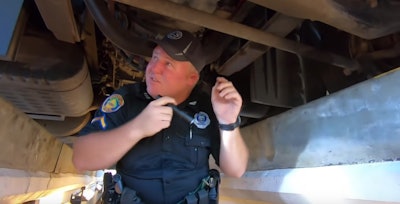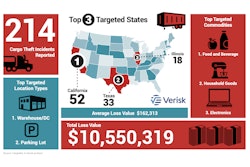
The latest inspection blitz of commercial vehicles across North America is at hand.
The Commercial Vehicle Safety Alliance’s annual International Roadcheck inspection blitz begins Tuesday, June 4 and continues through Thursday, June 6. This year inspectors will be paying close attention to steering components and suspension systems as they conduct their inspections.
During International Roadcheck, authorities will conduct the North American Standard Level I Inspection, a 37-step procedure that includes an examination of driver operating requirements and vehicle mechanical fitness. Inspectors may also opt to conduct the Level II Walk-Around Driver/Vehicle Inspection, Level III Driver/Credential/Administrative Inspection or Level V Vehicle-Only Inspection, according to the CVSA.
The vehicle inspection includes checking critical inspection items such as: brake systems; cargo securement; coupling devices; driveline/driveshaft; driver’s seat (missing); exhaust systems; frames; fuel systems; lighting devices (headlamps, tail lamps, stop lamps, turn signals and lamps/flags on projecting loads); steering mechanisms; suspensions; tires; van and open-top trailer bodies; wheels, rims and hubs; windshield wipers.
Drivers will be required to provide their driver’s license (operating credentials), Medical Examiner’s Certificate and Skill Performance Evaluation Certificate (if applicable), driver’s record of duty status and vehicle inspection report(s) (if applicable). Inspectors will also check drivers for seat belt usage, sickness, fatigue, and apparent alcohol and/or drug impairment.
If no critical vehicle inspection item violations are found during a Level I or Level V Inspection, a CVSA decal will be applied to the vehicle, indicating that the vehicle successfully passed a decal-eligible inspection conducted by a CVSA-certified inspector; however, when a rear impact guard is required and violations are present, a CVSA decal shall not be issued.
If an inspector identifies critical vehicle inspection item violations, he or she may render the vehicle out of service. This means the vehicle cannot be operated until the vehicle violation(s) are corrected. A driver can also be placed out of service for driver credential-related issues or driver conditions, such as fatigue or impairment.
Last year’s event sidelined nearly 12,000 trucks and buses and more than 2,600 drivers with out-of-service orders. Brakes, tires and wheels, and brake adjustment were the top three vehicle out-of-service violations issued during 2018’s Roadcheck. The top driver out-of-service violations were hours of service, wrong class license and false logs.








